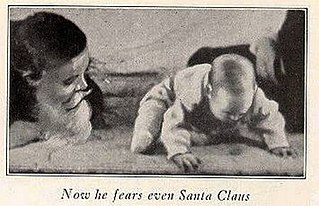Related Research Articles

Arachnophobia is the fear of spiders and other arachnids such as scorpions and ticks. The word Arachnophobia comes from the Greek words arachne and phobia.
Evolutionary psychology is a theoretical approach in psychology that examines cognition and behavior from a modern evolutionary perspective. It seeks to identify human psychological adaptations with regards to the ancestral problems they evolved to solve. In this framework, psychological traits and mechanisms are either functional products of natural and sexual selection or non-adaptive by-products of other adaptive traits.

Fear is an intensely unpleasant primal emotion in response to perceiving or recognizing a danger or threat. Fear causes psychological changes that may produce behavioral reactions such as mounting an aggressive response or fleeing the threat. Fear in human beings may occur in response to a certain stimulus occurring in the present, or in anticipation or expectation of a future threat perceived as a risk to oneself. The fear response arises from the perception of danger leading to confrontation with or escape from/avoiding the threat, which in extreme cases of fear can be a freeze response.

A phobia is an anxiety disorder, defined by an irrational, unrealistic, persistent and excessive fear of an object or situation. Phobias typically result in a rapid onset of fear and are usually present for more than six months. Those affected go to great lengths to avoid the situation or object, to a degree greater than the actual danger posed. If the object or situation cannot be avoided, they experience significant distress. Other symptoms can include fainting, which may occur in blood or injury phobia, and panic attacks, often found in agoraphobia and emetophobia. Around 75% of those with phobias have multiple phobias.
Specific phobia is an anxiety disorder, characterized by an extreme, unreasonable, and irrational fear associated with a specific object, situation, or concept which poses little or no actual danger. Specific phobia can lead to avoidance of the object or situation, persistence of the fear, and significant distress or problems functioning associated with the fear. A phobia can be the fear of anything.

The Little Albert experiment was a controversial study that mid-20th century psychologists interpret as evidence of classical conditioning in humans. The study is also claimed to be an example of stimulus generalization although reading the research report demonstrates that fear did not generalize by color or tactile qualities. It was carried out by John B. Watson and his graduate student, Rosalie Rayner, at Johns Hopkins University. The results were first published in the February 1920 issue of the Journal of Experimental Psychology.
Ergophobia is described as an extreme and debilitating fear associated with work, a fear of finding or losing employment, or fear of specific tasks in the workplace. The term ergophobia comes from the Greek "ergon" (work) and "phobos" (fear).

Martin Elias Peter Seligman is an American psychologist, educator, and author of self-help books. Seligman is a strong promoter within the scientific community of his theories of well-being and positive psychology. His theory of learned helplessness is popular among scientific and clinical psychologists. A Review of General Psychology survey, published in 2002, ranked Seligman as the 31st most cited psychologist of the 20th century.

Ophidiophobia is fear of snakes. It is sometimes called by the more general term herpetophobia, fear of reptiles. The word comes from the Greek words "ophis" (ὄφις), snake, and "phobia" (φοβία) meaning fear.
Behaviour therapy or behavioural psychotherapy is a broad term referring to clinical psychotherapy that uses techniques derived from behaviourism and/or cognitive psychology. It looks at specific, learned behaviours and how the environment, or other people's mental states, influences those behaviours, and consists of techniques based on behaviorism's theory of learning: respondent or operant conditioning. Behaviourists who practice these techniques are either behaviour analysts or cognitive-behavioural therapists. They tend to look for treatment outcomes that are objectively measurable. Behaviour therapy does not involve one specific method, but it has a wide range of techniques that can be used to treat a person's psychological problems.
Systematic desensitization, or graduated exposure therapy, is a behavior therapy developed by the psychiatrist Joseph Wolpe. It is used when a phobia or anxiety disorder is maintained by classical conditioning. It shares the same elements of both cognitive-behavioral therapy and applied behavior analysis. When used in applied behavior analysis, it is based on radical behaviorism as it incorporates counterconditioning principles. These include meditation and breathing. From the cognitive psychology perspective, cognitions and feelings precede behavior, so it initially uses cognitive restructuring.
Conditioned taste aversion occurs when an animal acquires an aversion to the taste of a food that was paired with aversive stimuli. The Garcia effect explains that the aversion develops more strongly for stimuli that cause nausea than other stimuli. This is considered an adaptive trait or survival mechanism that enables the organism to avoid poisonous substances before they cause harm. The aversion reduces consuming the same substance in the future, thus avoiding poisoning.
Affective neuroscience is the study of how the brain processes emotions. This field combines neuroscience with the psychological study of personality, emotion, and mood. The basis of emotions and what emotions are remains an issue of debate within the field of affective neuroscience.

An avoidance response is a response that prevents an aversive stimulus from occurring. It is a kind of negative reinforcement. An avoidance response is a behavior based on the concept that animals will avoid performing behaviors that result in an aversive outcome. This can involve learning through operant conditioning when it is used as a training technique. It is a reaction to undesirable sensations or feedback that leads to avoiding the behavior that is followed by this unpleasant or fear-inducing stimulus.
Fear of commitment, also known as gamophobia, is the irrational fear or avoidance of long-term partnership or marriage. The term is sometimes used interchangeably with commitment phobia, which describes a generalized fear or avoidance of commitments more broadly.
In psychology, desensitization is a treatment or process that diminishes emotional responsiveness to a negative, aversive, or positive stimulus after repeated exposure. Desensitization can also occur when an emotional response is repeatedly evoked when the action tendency associated with the emotion proves irrelevant or unnecessary. The process of desensitization was developed by psychologist Mary Cover Jones and is primarily used to assist individuals in unlearning phobias and anxieties. Desensitization is a psychological process where a response is repeatedly elicited in circumstances where the emotion's propensity for action is irrelevant. Joseph Wolpe (1958) developed a method of a hierarchal list of anxiety-evoking stimuli in order of intensity, which allows individuals to undergo adaptation. Although medication is available for individuals with anxiety, fear, or phobias, empirical evidence supports desensitization with high rates of cure, particularly in clients with depression or schizophrenia. Wolpe's "reciprocal inhibition" desensitization process is based on well-known psychology theories such as Hull's "drive-reduction" theory and Sherrington's concept of "reciprocal inhibition." Individuals are gradually exposed to anxiety triggers while using relaxation techniques to reduce anxiety. It is an effective treatment for anxiety disorders.

Adaptive memory is the study of memory systems that have evolved to help retain survival- and fitness-related information, i.e., that are geared toward helping an organism enhance its reproductive fitness and chances of surviving. One key element of adaptive memory research is the notion that memory evolved to help survival by better retaining information that is fitness-relevant. One of the foundations of this method of studying memory is the relatively little adaptive value of a memory system that evolved merely to remember past events. Memory systems, it is argued, must use the past in some service of the present or the planning of the future. Another assumption under this model is that the evolved memory mechanisms are likely to be domain-specific, or sensitive to certain types of information.

Trypophobia is an aversion to the sight of repetitive patterns or clusters of small holes or bumps. It is not officially recognized as a mental disorder, but may be diagnosed as a specific phobia if excessive fear and distress occur. Most affected people experience mainly disgust when they see trypophobic imagery. A minority of people experience the same level of fear and disgust, and a few express only disgust or fear.

The male warrior hypothesis (MWH) is an evolutionary psychology hypothesis by Professor Mark van Vugt which argues that human psychology has been shaped by between-group competition and conflict. Specifically, the evolutionary history of coalitional aggression between groups of men may have resulted in sex-specific differences in the way outgroups are perceived, creating ingroup vs. outgroup tendencies that are still observable today.

The snake detection theory, also sometimes called the snake detection hypothesis, suggests that snakes have contributed to the evolution of primates' visual system. According to the theory, predatory pressure from snakes has selected individuals who are better able to recognize them, improving their survival chances and therefore transferring such skill to their offspring. From this point of view, snakes were responsible for the modification and expansion of primate visual systems which made vision the most developed sensory interface with the external environment for modern primates. In her book The Fruit, the Tree, and the Serpent (2009), anthropologist Lynne Isbell writes that snakes evolved to be difficult to detect and mortally dangerous. Surviving the peril of snakes for millions of years required selective pressure favoring primates' specialized visual systems. Compared to that of other mammals, the pulvinar region of the brain – which helps to visually detect relevant objects – is disproportionately large and effective in the brains of primates.
References
- ↑ Seligman, Martin E. (1970). "On the generality of the laws of learning". Psychological Review. 77 (5): 406–418. doi:10.1037/h0029790.
- ↑ Seligman, Martin E.P. (July 1971). "Phobias and preparedness". Behavior Therapy. 2 (3): 307–320. doi:10.1016/S0005-7894(71)80064-3.
- ↑ Öhman, Arne; Mineka, Susan (2001). "Fears, phobias, and preparedness: Toward an evolved module of fear and fear learning". Psychological Review. 108 (3): 483–522. doi:10.1037/0033-295X.108.3.483. PMID 11488376.
- ↑ Garcia, J; Kimeldorf, D J; Koelling, R A (1955). "Conditioned Aversion to Saccharin Resulting from Exposure to Gamma Radiation". Science. 122 (3160): 157–158. Bibcode:1955Sci...122..157G. doi:10.1126/science.122.3160.157. PMID 14396377. S2CID 30826975.